Advantage of Regional Algorithms for the Chlorophyll-a Concentration Retrieval from In Situ Optical Measurements in the Kara Sea
Abstract
:1. Introduction
2. Materials and Methods
2.1. Study Area
2.2. Field Measurements
2.2.1. Upwelling Radiation Hyperspectral Measurements
- -
- the total upwelling radiance from the sea surface (Figure 3a);
- -
- the radiance reflected from water surface , in the cuvette with walls and bottom made of dark neutral glass TC-3 [31] with absorption >99% in the visible range. Dimensions of the cuvette are 100 × 100 × 250 mm. The cuvette has a layer of water about 5 cm, so the water leaving radiance of the cuvette was negligible (Figure 3b);
- -
- the radiance of the horizontal white Lambertian panel . with known reflection coefficient , giving the downwelling irradiance (Figure 3c).
2.2.2. Chlorophyll-a Concentration Measurements
2.3. Satellite Data
2.4. Bio-Optical Algorithms
2.4.1. Adaptation of the Black Sea MHI Algorithm
2.4.2. Regional Empirical Bio-Optical Model for the Kara Sea
2.5. Error Assessment
3. Results
3.1. Field Measurements of Rrs
3.2. Comparison of In Situ and Remote Sensing Rrs Spectra
3.3. Comparison of the Different Chlorophyll Algorithms
4. Discussion
5. Conclusions
Author Contributions
Funding
Institutional Review Board Statement
Informed Consent Statement
Data Availability Statement
Acknowledgments
Conflicts of Interest
References
- Demidov, A.B.; Sheberstov, S.V.; Gagarin, V.I. Estimation of the annual Kara Sea primary production. Oceanology 2018, 58, 369–380. [Google Scholar] [CrossRef]
- Park, J.-Y.; Kug, J.-S.; Bader, J.; Rolph, R.; Kwon, M. Amplified Arctic warming by phytoplankton under greenhouse warming. Proc. Natl. Acad. Sci. USA 2015, 112, 5921–5926. [Google Scholar] [CrossRef] [PubMed] [Green Version]
- Jin, Z.; Charlock, T.P.; Rutledge, K. Analysis of Broadband Solar Radiation and Albedo over the Ocean Surface at COVE. J. Atmos. Ocean. Technol. 2002, 19, 1585–1601. [Google Scholar] [CrossRef]
- Zhao, D.; Xu, Y.; Zhang, X.; Huang, C. Global chlorophyll distribution induced by mesoscale eddies. Remote Sens. Environ. 2021, 254, 112245. [Google Scholar] [CrossRef]
- Werdell, P.J.; Franz, B.A.; Bailey, S.W.; Feldman, G.C.; Boss, E.; Brando, V.E.; Mangin, A. Generalized ocean color inversion model for retrieving marine inherent optical properties. Appl. Opt. 2013, 52, 2019–2037. [Google Scholar] [CrossRef] [Green Version]
- Hu, C.; Lee, Z.; Franz, B. Chlorophyll a algorithms for oligotrophic oceans: A novel approach based on three-band reflectance difference. J. Geophys. Res. 2012, 117. [Google Scholar] [CrossRef] [Green Version]
- Zavialov, P.O.; Izhitskiy, A.S.; Osadchiev, A.A.; Pelevin, V.V.; Grabovskiy, A.B. The structure of thermohaline and bio-optical fields in the surface layer of the Kara Sea in September 2011. Oceanology 2015, 55, 461–471. [Google Scholar] [CrossRef]
- Demidov, A.B.; Gagarin, V.I.; Vorobieva, O.V.; Makkaveev, P.N.; Artemiev, V.A.; Khrapko, A.N.; Grigoriev, A.V.; Sheberstov, S.V. Spatial and vertical variability of primary production in the Kara Sea in July and August 2016: The influence of the river plume and subsurface chlorophyll maxima. Polar Biol. 2018, 41, 563–578. [Google Scholar] [CrossRef]
- Qu, B.; Gabric, A.J.; Matrai, P.A. The satellite-derived distribution of chlorophyll-a and its relation to ice cover, radiation and sea surface temperature in the Barents Sea. Polar Biol. 2006, 29, 196–210. [Google Scholar] [CrossRef]
- Glukhovets, D.; Kopelevich, O.; Yushmanova, A.; Vazyulya, S.; Sheberstov, S.; Karalli, P.; Sahling, I. Evaluation of the CDOM Absorption Coefficient in the Arctic Seas Based on Sentinel-3 OLCI Data. Remote Sens. 2020, 12, 3210. [Google Scholar] [CrossRef]
- Lewis, K.M.; Mitchell, B.G.; Van Dijken, G.L.; Arrigo, K.R. Regional chlorophyll a algorithms in the Arctic Ocean and their effect on satellite-derived primary production estimates. Deep Sea Res. Part II Top. Stud. Oceanogr. 2016, 130, 14–27. [Google Scholar] [CrossRef]
- Kopelevich, O.V.; Sahling, I.V.; Vazyulya, S.V.; Glukhovets, D.I.; Sheberstov, S.V.; Burenkov, V.I.; Karalli, P.G.; Yushmanova, A.V. Bio-Optical Characteristics of the Seas, Surrounding the Western Part of Russia, from Data of the Satellite Ocean Color Scanners of 1998–2017; OOO “VASh FORMAT,”: Moscow, Russia, 2018; ISBN 9785907092471. (In Russian) [Google Scholar]
- Antonov, N.P.; Kuznetsov, V.V.; Kuznetsova, E.N.; Tatarnikov, V.A.; Belorustseva, S.A.; Mitenkova, L.V. Ecology of Arctic cod Boreogadus saida (Gadiformes, Gadidae) and its fishery potential in Kara Sea. J. Ichthyol. 2017, 57, 721–729. [Google Scholar] [CrossRef]
- Demidov, A.B.; Kopelevich, O.V.; Mosharov, S.A.; Sheberstov, S.V.; Vazyulya, S.V. Modelling Kara Sea phytoplankton primary production: Development and skill assessment of regional algorithms. J. Sea Res. 2017, 125, 1–17. [Google Scholar] [CrossRef]
- Morel, A.; Prieur, L. Analysis of variations in ocean color. Limnol. Oceanogr. 1977, 22, 709–722. [Google Scholar] [CrossRef]
- Glukhovets, D.I.; Goldin, Y.A. Surface desalinated layer distribution in the Kara Sea determined by shipboard and satellite data. Oceanologia 2020, 62, 364–373. [Google Scholar] [CrossRef]
- Osadchiev, A.A.; Frey, D.I.; Shchuka, S.A.; Tilinina, N.D.; Morozov, E.G.; Zavialov, P.O. Structure of the Freshened Surface Layer in the Kara Sea During Ice-Free Periods. J. Geophys. Res. Oceans 2021, 126, e2020JC016486. [Google Scholar] [CrossRef]
- Drozdova, A.N.; Nedospasov, A.A.; Lobus, N.V.; Patsaeva, S.V.; Shchuka, S.A. CDOM Optical Properties and DOC Content in the Largest Mixing Zones of the Siberian Shelf Seas. Remote Sens. 2021, 13, 1145. [Google Scholar] [CrossRef]
- Kuznetsova, O.A.; Kopelevich, O.V.; Sheberstov, S.V. Analysis of the chlorophyll concentration in the Kara Sea according to MODIS-AQUA satellite scanner. Issled. Zemli iz Kosm. (Earth Res. Space) 2013, 5, 21–31. (In Russian) [Google Scholar] [CrossRef]
- O’Reilly, J.E.; Maritorena, S.; Mitchell, B.G.; Siegel, D.A.; Carder, K.L.; Garver, S.A.; Kahru, M.; McClain, C.R. Ocean color chlorophyll algorithms for SeaWiFS. J. Geophys. Res. 1998, 103, 24937–24953. [Google Scholar] [CrossRef] [Green Version]
- Gordon, H.R.; Wang, M. Retrieval of water-leaving radiance and aerosol optical thickness over the oceans with SeaWiFS: A preliminary algorithm. Appl. Opt. 1994, 33, 443–452. [Google Scholar] [CrossRef]
- Belanger, S.; Ehn, J.K.; Babin, M. Impact of sea ice on the retrieval of water-leaving reflectance, chlorophyll a concentration and inherent optical properties from satellite ocean color data. Remote Sens. Environ. 2007, 111, 51–68. [Google Scholar] [CrossRef]
- Wang, M.H.; Shi, W. Detection of Ice and Mixed Ice-Water Pixels for MODIS Ocean Color Data Processing. IEEE Trans. Geosci. Remote Sens. 2009, 47, 2510–2518. [Google Scholar] [CrossRef]
- Zege, E.; Malinka, A.; Katsev, I.; Prikhach, A.; Heygster, G.; Istomina, L.; Birnbaum, G.; Schwarz, P. Algorithm to retrieve the melt pond fraction and the spectral albedo of Arctic summer ice from satellite optical data. Remote Sens. Environ. 2015, 163, 153–164. [Google Scholar] [CrossRef] [Green Version]
- Frouin, R.; Deschamps, P.-Y.; Ramon, D.; Steinmetz, F. Improved ocean-color remote sensing in the Arctic using the POLYMER algorithm. In Proceedings of the Remote Sensing of the Marine Environment II, Kyoto, Japan, 29 October–1 November 2012; p. 85250I. [Google Scholar] [CrossRef]
- König, M.; Hieronymi, M.; Oppelt, N. Application of Sentinel-2 MSI in Arctic Research: Evaluating the Performance of Atmospheric Correction Approaches Over Arctic Sea Ice. Front. Earth Sci. 2019, 7, 22. [Google Scholar] [CrossRef] [Green Version]
- Kopelevich, O.V.; Sheberstov, S.V.; Vazyulya, S.V.; Zolotov, I.G.; Bailey, S.W. New approach to atmospheric correction of satellite ocean color data. In Proceedings of the Current Research on Remote Sensing, Laser Probing, and Imagery in Natural Waters, Moscow, Russia, 1–3 January 2007; p. 661502. [Google Scholar] [CrossRef]
- Korchemkina, E.N.; Kalinskaya, D.V. Algorithm of Additional Correction of Level 2 Remote Sensing Reflectance Data Using Modelling of the Optical Properties of the Black Sea Waters. Remote Sens. 2022, 14, 831. [Google Scholar] [CrossRef]
- Mobley, C.D. Estimation of the remote sensing reflectance from above–water methods. Appl. Opt. 1999, 38, 7442–7455. [Google Scholar] [CrossRef]
- Molkov, A.A.; Fedorov, S.V.; Pelevin, V.V.; Korchemkina, E.N. Regional Models for High-Resolution Retrieval of Chlorophyll a and TSM Concentrations in the Gorky Reservoir by Sentinel-2 Imagery. Remote Sens. 2019, 11, 1215. [Google Scholar] [CrossRef] [Green Version]
- Coloured Optical Glass. Specifications. Available online: https://docs.cntd.ru/document/1200023782 (accessed on 28 September 2022).
- Mueller, J.L.; Fargion, G.S.; McClain, C.R. Ocean Optics Protocols for Satellite Ocean Color Sensor Validation, Revision 5, Volume V: Biogeochemical and Bio-Optical Measurements and Data Analysis Protocols; NASA Tech: Washington, DC, USA, 2003. [Google Scholar]
- Karalli, P.G.; Kopelevich, O.V.; Sahling, I.V.; Sheberstov, S.V.; Pautova, L.V.; Silkin, V.A. Validation of remote sensing estimates of coccolitophore bloom parameters in the Barents Sea from field measurements. Fundam. Apll. Hydrophys. 2018, 11, 55–63. [Google Scholar] [CrossRef]
- Korchemkina, E.N.; Mankovskaya, E.V. Bio-optical properties of Black Sea waters during coccolithophore bloom in July 2017. In Proceedings of the 25th International Symposium on Atmospheric and Ocean Optics: Atmospheric Physics, Novosibirsk, Russia, 1–5 July 2019; Volume 11208, pp. 1070–1074. [Google Scholar] [CrossRef]
- Lee, M.E.; Shybanov, E.B.; Korchemkina, E.N.; Martynov, O.V. Retrieval of concentrations of seawater natural components from reflectance spectrum. In Proceedings of the 22nd International Symposium on Atmospheric and Ocean Optics: Atmospheric Physics, Tomsk, Russia, 30 June–3 July 2016; Volume 10035, pp. 629–643. [Google Scholar] [CrossRef]
- Arar, E.G.; Collins, G.B. Environmental Protection Agency Method 445.0 In Vitro Determination of Chlorophyll a and Pheophytin a in Marine and Freshwater Algae by Fluorescence, Revision 1.2; Environmental Protection Agency, National Exposure Research Laboratory, Office of Research and Development: Cincinnati, OH, USA, 1997; pp. 1–22.
- Holm-Hansen, O.; Riemann, B. Chlorophyll a determination: Improvements in methodology. Oikos 1978, 30, 438–447. [Google Scholar] [CrossRef]
- Oceancolor Web. Available online: https://oceancolor.gsfc.nasa.gov/ (accessed on 14 June 2022).
- Copernicus Online Data Access. Available online: https://coda.eumetsat.int (accessed on 14 June 2022).
- Bailey, S.W.; Werdell, P.J. A multi-sensor approach for the on-orbit validation of ocean color satellite data products. Remote Sens. Environ. 2006, 102, 12–23. [Google Scholar] [CrossRef]
- Sheberstov, S.V. System for batch processing of oceanographic satellite data. Sovr. Probl. DZZ Kosm. 2015, 12, 154–161. (In Russian) [Google Scholar]
- Maritorena, S.; Siegel, D.A.; Peterson, A.R. Optimization of a semianalytical ocean color model for global-scale applications. Appl. Opt. 2002, 41, 2705–2714. [Google Scholar] [CrossRef] [PubMed]
- Smith, R.C.; Baker, K.S. Optical properties of the clearest natural waters (200–800 nm). Appl. Opt. 1981, 20, 177–184. [Google Scholar] [CrossRef] [PubMed]
- Bricaud, A.; Babin, M.; Morel, A.; Claustre, H. Variability in the chlorophyll-specific absorption coefficients of natural phytoplankton: Analysis and parameterization. J. Geophys. Res. Oceans 1995, 100, 13321–13332. [Google Scholar] [CrossRef]
- Bricaud, A.; Morel, A.; Prieur, L. Absorption by dissolved organic matter of the sea (yellow substance) in the UV and visible domains. Limnol. Oceanogr. 1981, 26, 43–53. [Google Scholar] [CrossRef]
- Wei, J.; Lee, Z.; Ondrusek, M.; Mannino, A.; Tzortziou, M.; Armstrong, R. Spectral slopes of the absorption coefficient of colored dissolved and detrital material inverted from UV-visible remote sensing reflectance. J. Geophys. Res. Oceans 2016, 121, 1953–1969. [Google Scholar] [CrossRef] [Green Version]
- Nima, C.; Frette, Ø.; Hamre, B.; Stamnes, J.J.; Chen, Y.C.; Sørensen, K.; Norli, M.; Lu, D.; Xing, Q.; Muyimbwa, D.; et al. CDOM Absorption Properties of Natural Water Bodies along Extreme Environmental Gradients. Water 2019, 11, 1988. [Google Scholar] [CrossRef]
- Pashovkina, A.; Fedorova, I. Coloured dissolved organic matter in aquatic ecosystems of three representative regions of the Arctic according to the data obtained in year 2019. E3S Web Conf. 2020, 163, 04006. [Google Scholar] [CrossRef]
- Stedmon, C.A.; Amon, R.M.W.; Rinehart, A.J.; Walker, S.A. The supply and characteristics of colored dissolved organic matter (CDOM) in the Arctic Ocean: Pan Arctic trends and differences. Mar. Chem. 2011, 124, 108–118. [Google Scholar] [CrossRef]
- Korchemkina, E.N.; Molkov, A.A. Regional bio-optical algorithm for Gorky reservoir: First results. Sovr. Probl. DZZ Kosm. 2018, 15, 184–192. [Google Scholar] [CrossRef]
- Kuznetsova, O.A.; Kopelevich, O.V.; Burenkov, V.I.; Sheberstov, S.V.; Kravchishina, M.D. Development of the regional algorithm for assessment of suspended matter concentration in the Kara Sea from satellite ocean color data. In Proceedings of the VII International Conference «Current problems in Optics of Natural Waters», Saint Petersburg, Russia, 10–14 September 2013; pp. 177–181, ISBN 9785020383678. [Google Scholar]
- Lavigne, H.; Van der Zande, D.; Ruddick, K.; Cardoso Dos Santos, J.F.; Gohin, F.; Brotas, V.; Kratzer, S. Quality-control tests for OC4, OC5 and NIR-red satellite chlorophyll-a algorithms applied to coastal waters. Remote Sens. Environ. 2021, 255, 112237. [Google Scholar] [CrossRef]
- Tilstone, G.H.; Lotliker, A.A.; Miller, P.I.; Ashraf, P.M.; Kumar, T.S.; Suresh, T.; Ragavan, B.R.; Menon, H.B. Assessment of MODIS-Aqua chlorophyll-a algorithms in coastal and shelf waters of the eastern Arabian Sea. Cont. Shelf Res. 2013, 65, 14–26. [Google Scholar] [CrossRef]
- Dobrovol’skii, A.D.; Zalogin, B.S. Seas of the USSR; Moscow University: Moscow, Russia, 1982. [Google Scholar]
- Lee, Z.P.; Du, K.; Voss, K.J.; Zibordi, G.; Lubac, B.; Arnone, R.; Weidemann, A. An inherent-optical-property-centered approach to correct the angular effects in water-leaving radiance. Appl. Opt. 2011, 50, 3155–3167. [Google Scholar] [CrossRef] [PubMed]
- Franz, B.A.; Werdell, P.J. A generalized framework for modeling of inherent optical properties in ocean remote sensing applications. In Proceedings of the Ocean Optics, Anchorage, AK, USA, 27 September–1 October 2010. [Google Scholar]
- Gong, G.C.; Wen, Y.H.; Wang, B.W.; Liu, G.J. Seasonal variation of chlorophyll a concentration, primary production and environmental conditions in the subtropical East China Sea. Deep. Sea Res. Part II Top. Stud. Oceanogr. 2003, 50, 1219–1236. [Google Scholar] [CrossRef]
- Garcia, C.A.E.; Garcia, V.M.T. Variability of chlorophyll-a from ocean color images in the La Plata continental shelf región. Cont. Shelf Res. 2008, 28, 1568–1578. [Google Scholar] [CrossRef]
- Glukhovets, D.I.; Goldin, Y.A. Express method for chlorophyll concentration assessment. J. Photochem. Photobiol. 2021, 8, 100083. [Google Scholar] [CrossRef]
- Goldin, Y.A.; Glukhovets, D.I.; Gureev, B.A.; Grigoriev, A.V.; Artemiev, V.A. Shipboard flow-through complex for measuring bio-optical and hydrological seawater characteristics. Oceanology 2020, 60, 713–720. [Google Scholar] [CrossRef]

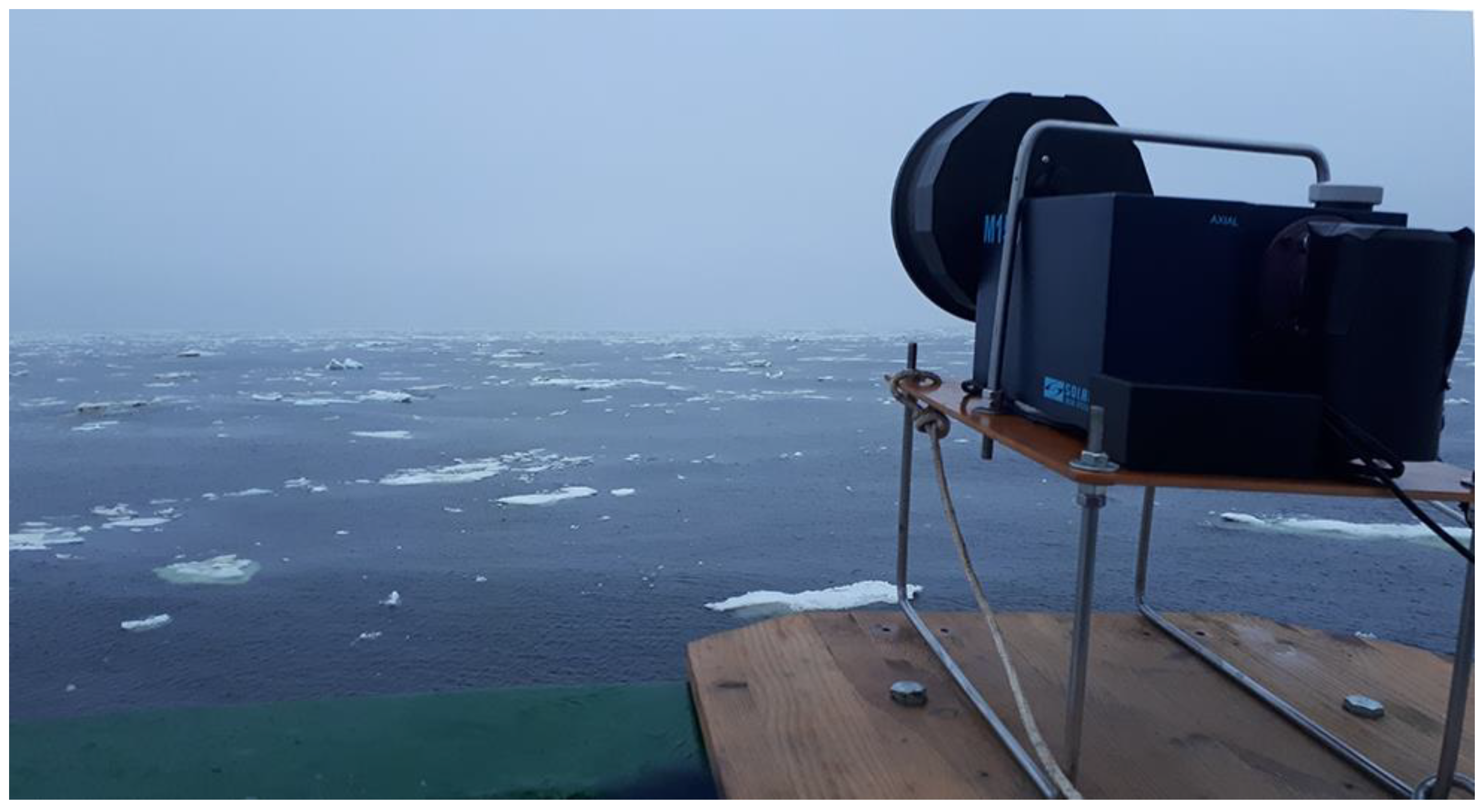


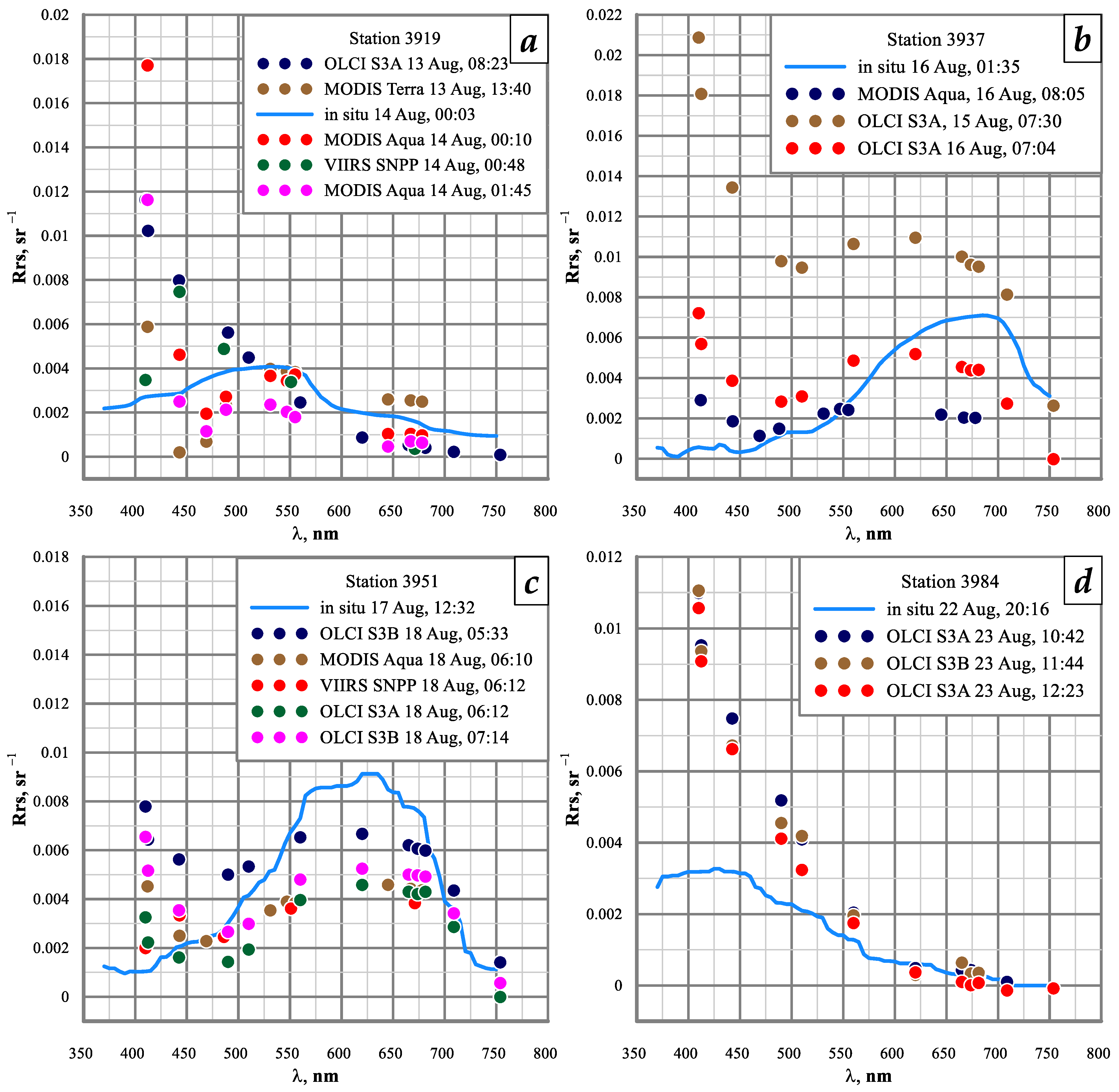
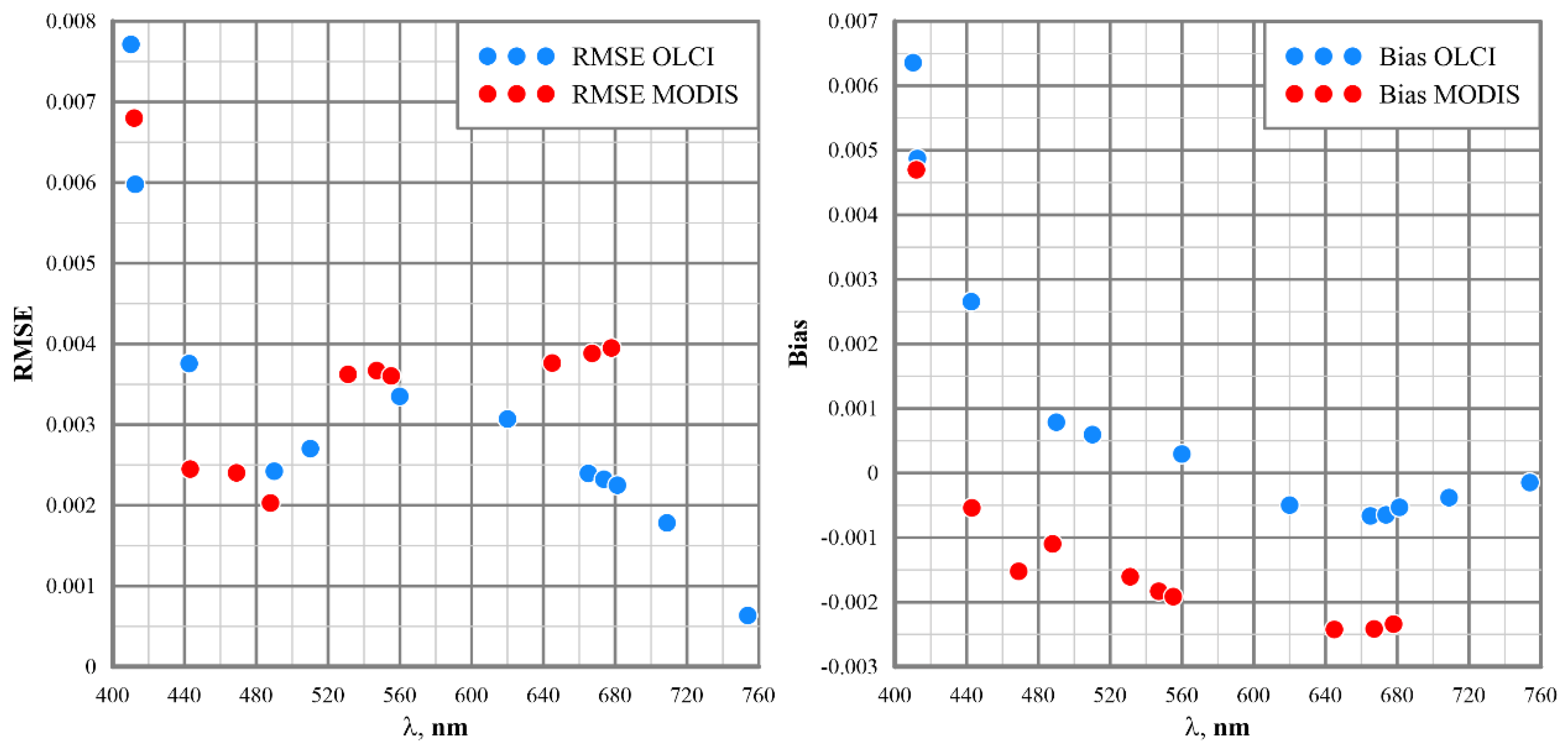

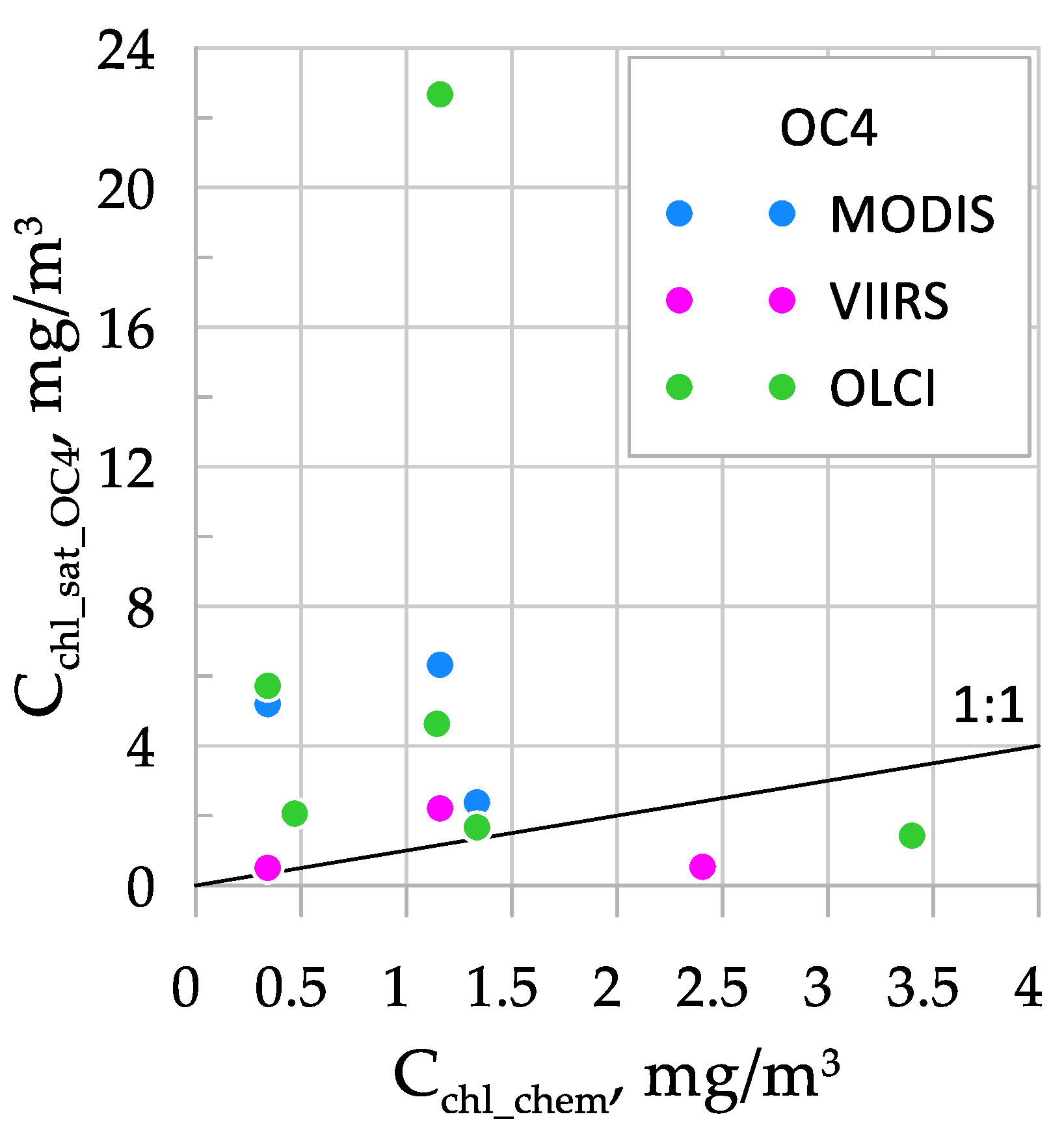
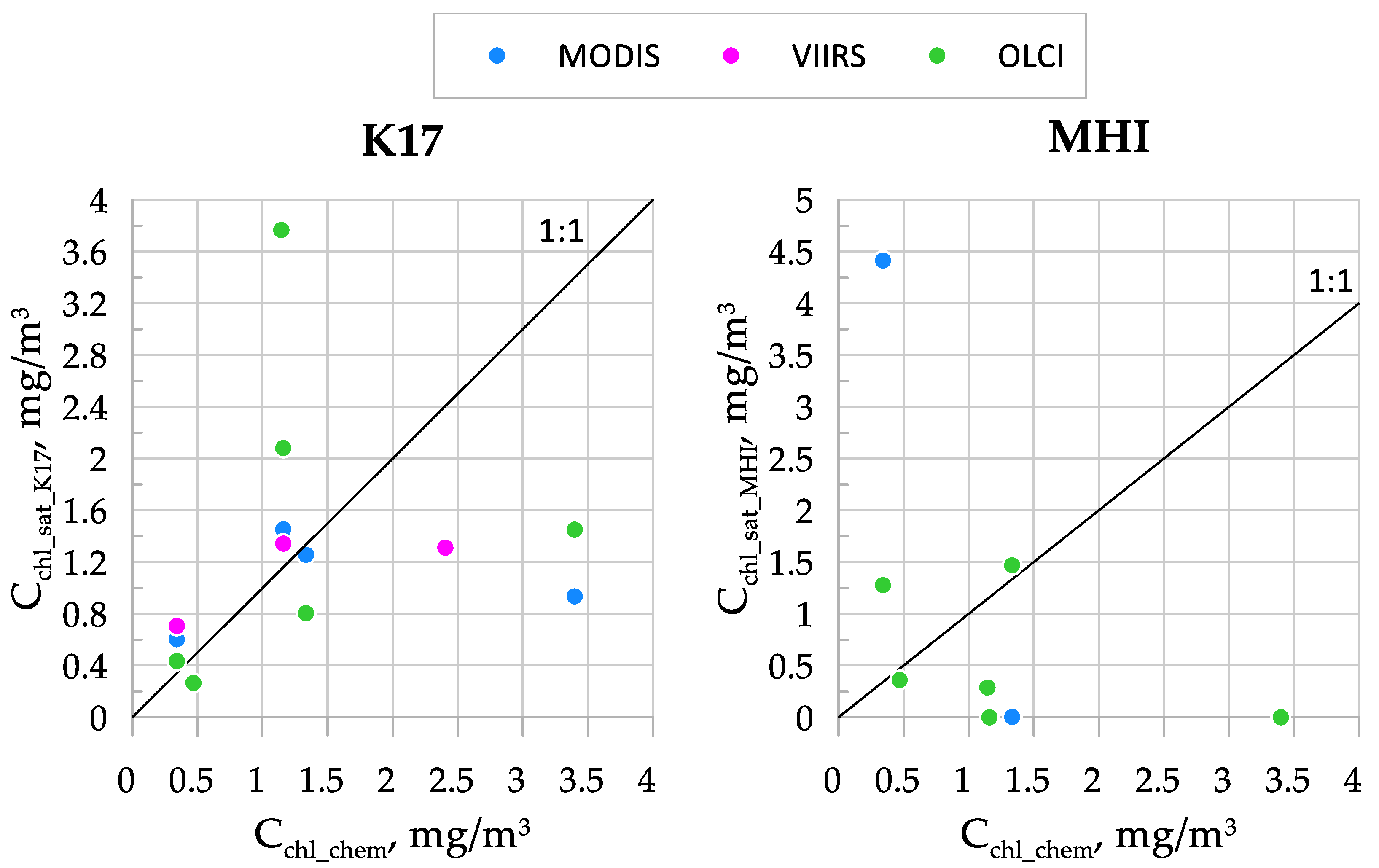
| Study Area | In Situ | Satellite Rrs | |||
|---|---|---|---|---|---|
| Rrs | Chl | MODIS A/T | VIIRS SNPP | OLCI S3A/B | |
| Kara Gates | 2 | - | - | - | - |
| Central part | 3 | - | 4 | 1 | 1 |
| Ob Bay | 3 | 3 | 1 | 1 | 2 |
| Yenisei Bay | 5 | 3 | 2 | 1 | 4 |
| Pyasina Bay | 2 | 2 | 1 | 1 | 5 |
| Northern part | 13 | 2 | - | - | 6 |
| Station | In Situ | GIOP | OC2 | OC3 | OC4 | K17 | MHI | |
|---|---|---|---|---|---|---|---|---|
| Ob Bay | 3931 | 2.41 | 0.05 | 0.78 | 1.53 | 19.98 | 1.97 | 1.81 |
| 3937 | 3.40 | −9.07 | 0.86 | 1.8 | 104.80 | 4.96 | 5.01 | |
| 3939 | 1.79 | −1.22 | 0.48 | 0.73 | 3.71 | 0.79 | 1.22 | |
| Yenisey Bay | 3951 | 1.16 | −5.59 | 0.44 | 0.63 | 8.92 | 2.87 | 2.50 |
| 3952 | 1.14 | 13.85 | 0.25 | 0.24 | 2.39 | 1.59 | 1.40 | |
| 3955 | 1.33 | 55.47 | 0.34 | 0.42 | 3.07 | 0.75 | 1.81 | |
| Pyasina Bay | 3956 | 0.47 | −7.58 | 0.29 | 0.32 | 1.63 | 1.31 | 0.54 |
| 3965 | 0.34 | −2.29 | 0.38 | 0.49 | 3.21 | 0.74 | 0.89 | |
| Northern part | 3968 | 0.27 | 0.59 | −0.07 | −0.28 | 0.14 | 0.07 | 0.33 |
| 3969 | 0.09 | 0.40 | −0.05 | −0.25 | 0.20 | 0.21 | 0.20 |
| Station | In Situ | OC4 | K17 | MHI | ||||||
|---|---|---|---|---|---|---|---|---|---|---|
| MODIS | VIIRS | OLCI | MODIS | VIIRS | OLCI | MODIS | OLCI | |||
| Ob Bay | 3931 | 2.41 | - | 0.53 | - | - | 1.31 | - | - | - |
| 3937 | 3.40 | - | - | 1.43 | 0.93 | - | 1.45 | - | 0.002 | |
| 3939 | 1.79 | - | - | - | - | - | - | - | - | |
| Yenisey Bay | 3951 | 1.16 | 6.32 | 2.21 | 22.67 | 1.45 | 1.34 | 2.08 | 0.002 | 0.001 |
| 3952 | 1.14 | - | - | 4.63 | - | - | 3.77 | - | 0.29 | |
| 3955 | 1.33 | 2.38 | - | 1.67 | 1.26 | - | 0.80 | 0.003 | 1.47 | |
| Pyasina Bay | 3956 | 0.47 | - | - | 2.06 | - | - | 0.27 | - | 0.36 |
| 3965 | 0.34 | 5.20 | 0.50 | 5.72 | 0.60 | 0.71 | 0.43 | 4.41 | 1.28 | |
Publisher’s Note: MDPI stays neutral with regard to jurisdictional claims in published maps and institutional affiliations. |
© 2022 by the authors. Licensee MDPI, Basel, Switzerland. This article is an open access article distributed under the terms and conditions of the Creative Commons Attribution (CC BY) license (https://creativecommons.org/licenses/by/4.0/).
Share and Cite
Korchemkina, E.; Deryagin, D.; Pavlova, M.; Kostyleva, A.; Kozlov, I.E.; Vazyulya, S. Advantage of Regional Algorithms for the Chlorophyll-a Concentration Retrieval from In Situ Optical Measurements in the Kara Sea. J. Mar. Sci. Eng. 2022, 10, 1587. https://doi.org/10.3390/jmse10111587
Korchemkina E, Deryagin D, Pavlova M, Kostyleva A, Kozlov IE, Vazyulya S. Advantage of Regional Algorithms for the Chlorophyll-a Concentration Retrieval from In Situ Optical Measurements in the Kara Sea. Journal of Marine Science and Engineering. 2022; 10(11):1587. https://doi.org/10.3390/jmse10111587
Chicago/Turabian StyleKorchemkina, Elena, Dmitriy Deryagin, Mariia Pavlova, Anna Kostyleva, Igor E. Kozlov, and Svetlana Vazyulya. 2022. "Advantage of Regional Algorithms for the Chlorophyll-a Concentration Retrieval from In Situ Optical Measurements in the Kara Sea" Journal of Marine Science and Engineering 10, no. 11: 1587. https://doi.org/10.3390/jmse10111587
APA StyleKorchemkina, E., Deryagin, D., Pavlova, M., Kostyleva, A., Kozlov, I. E., & Vazyulya, S. (2022). Advantage of Regional Algorithms for the Chlorophyll-a Concentration Retrieval from In Situ Optical Measurements in the Kara Sea. Journal of Marine Science and Engineering, 10(11), 1587. https://doi.org/10.3390/jmse10111587






